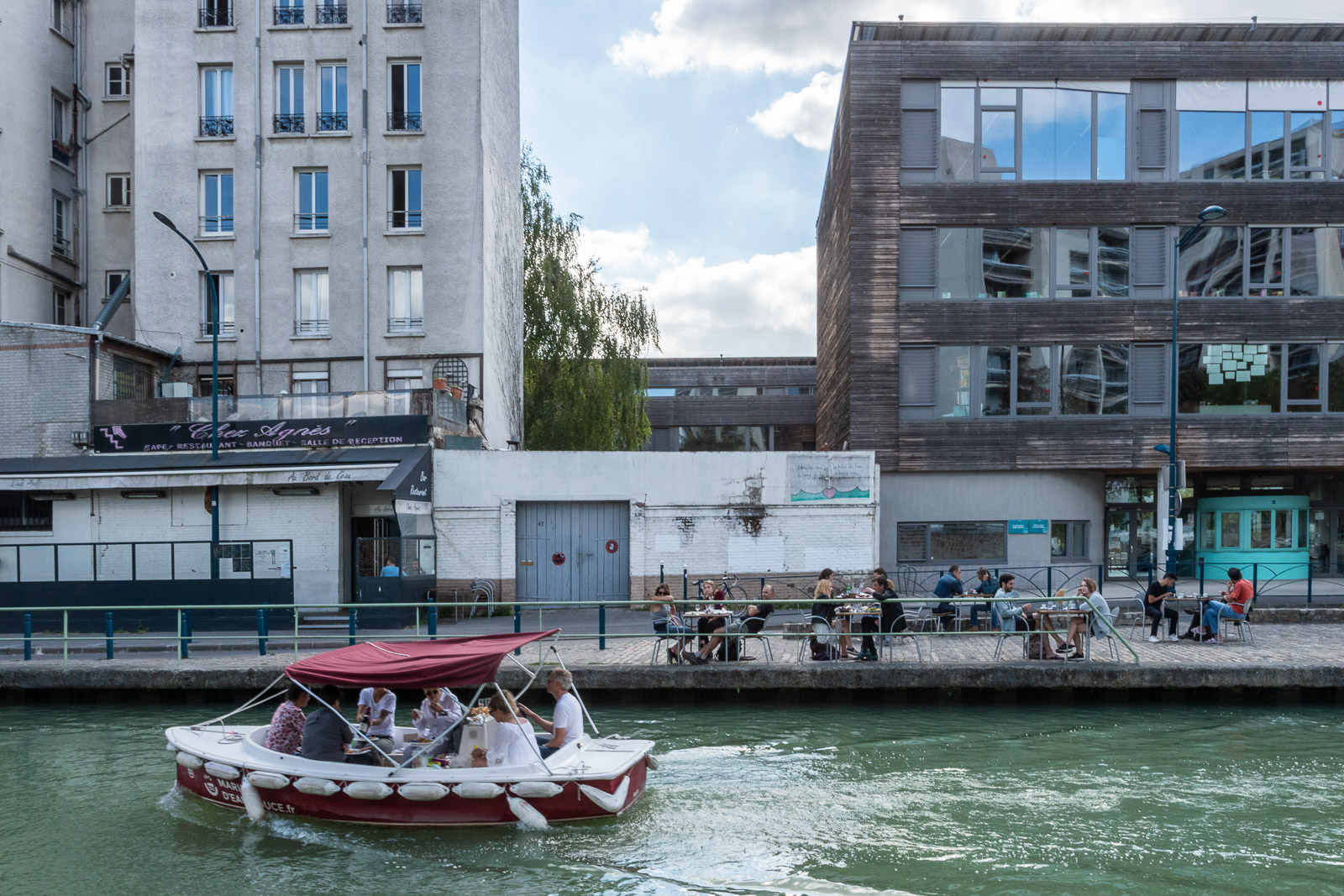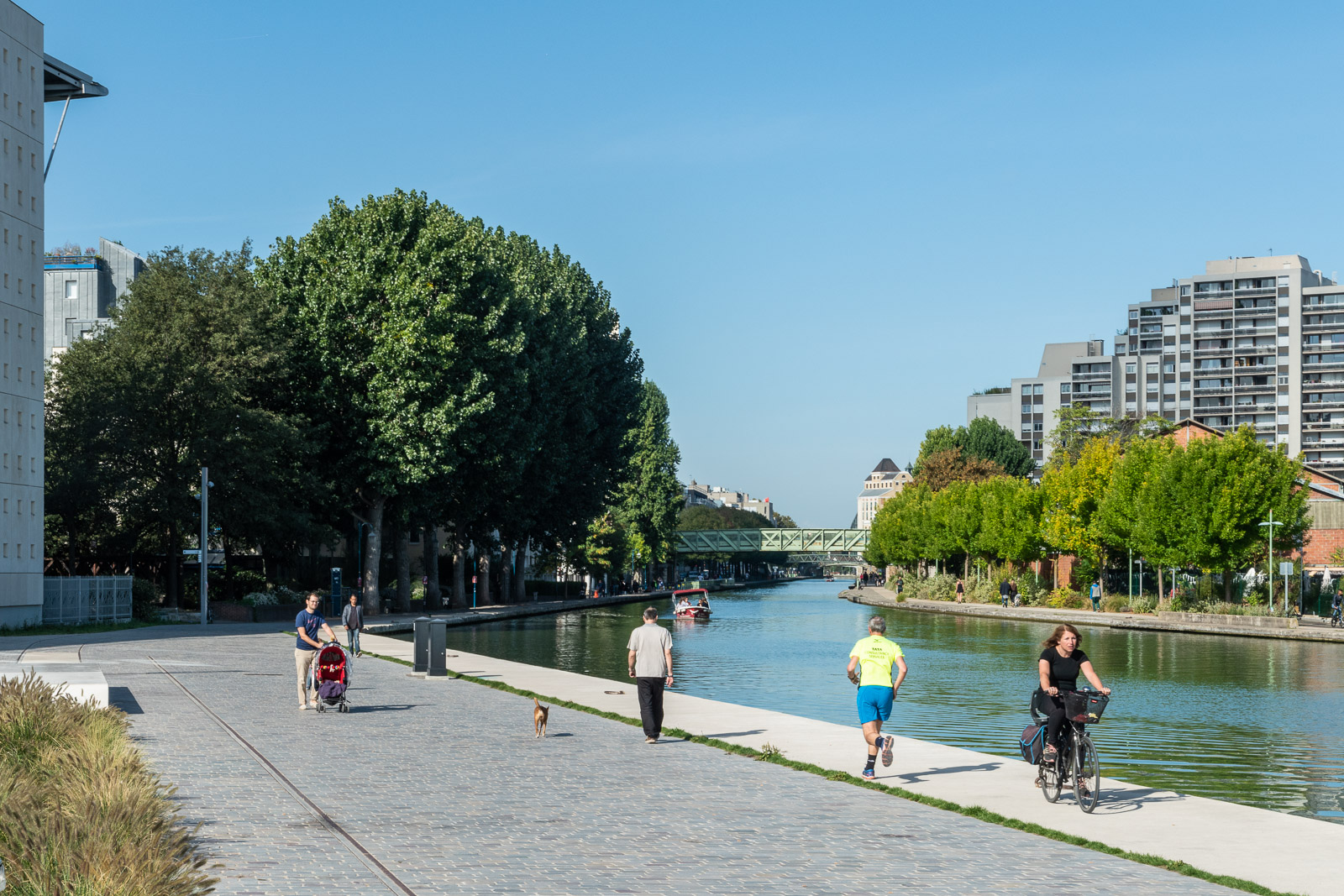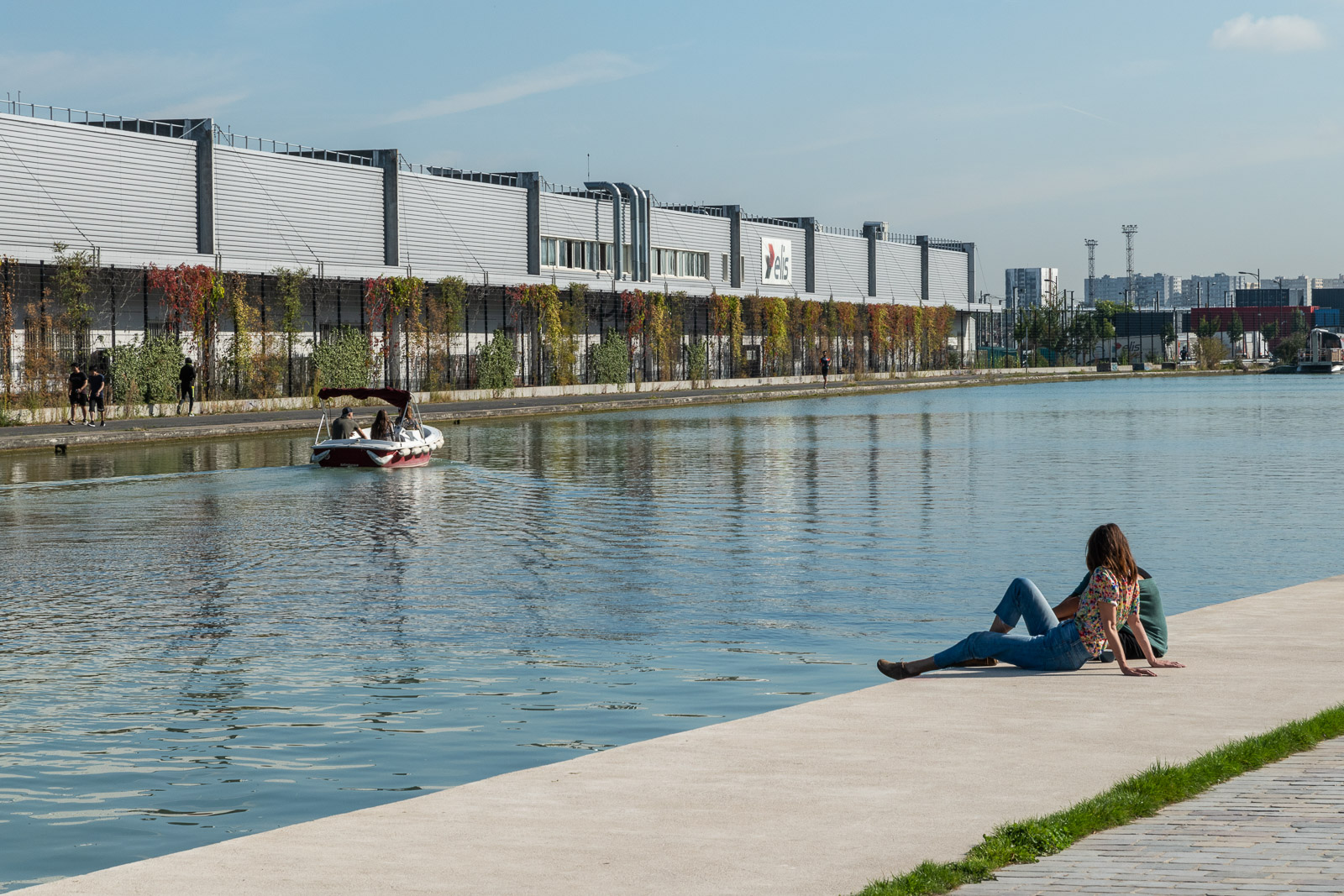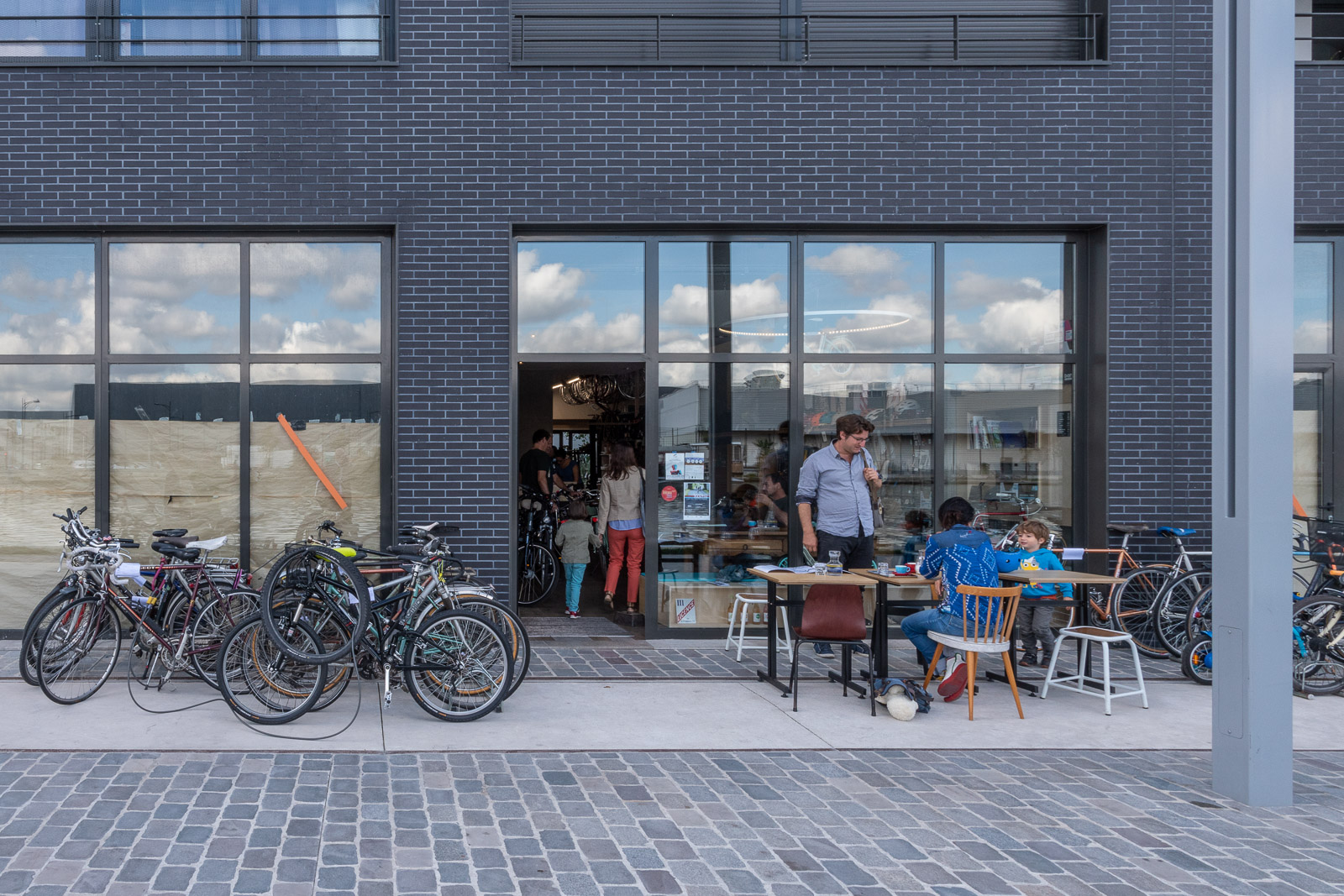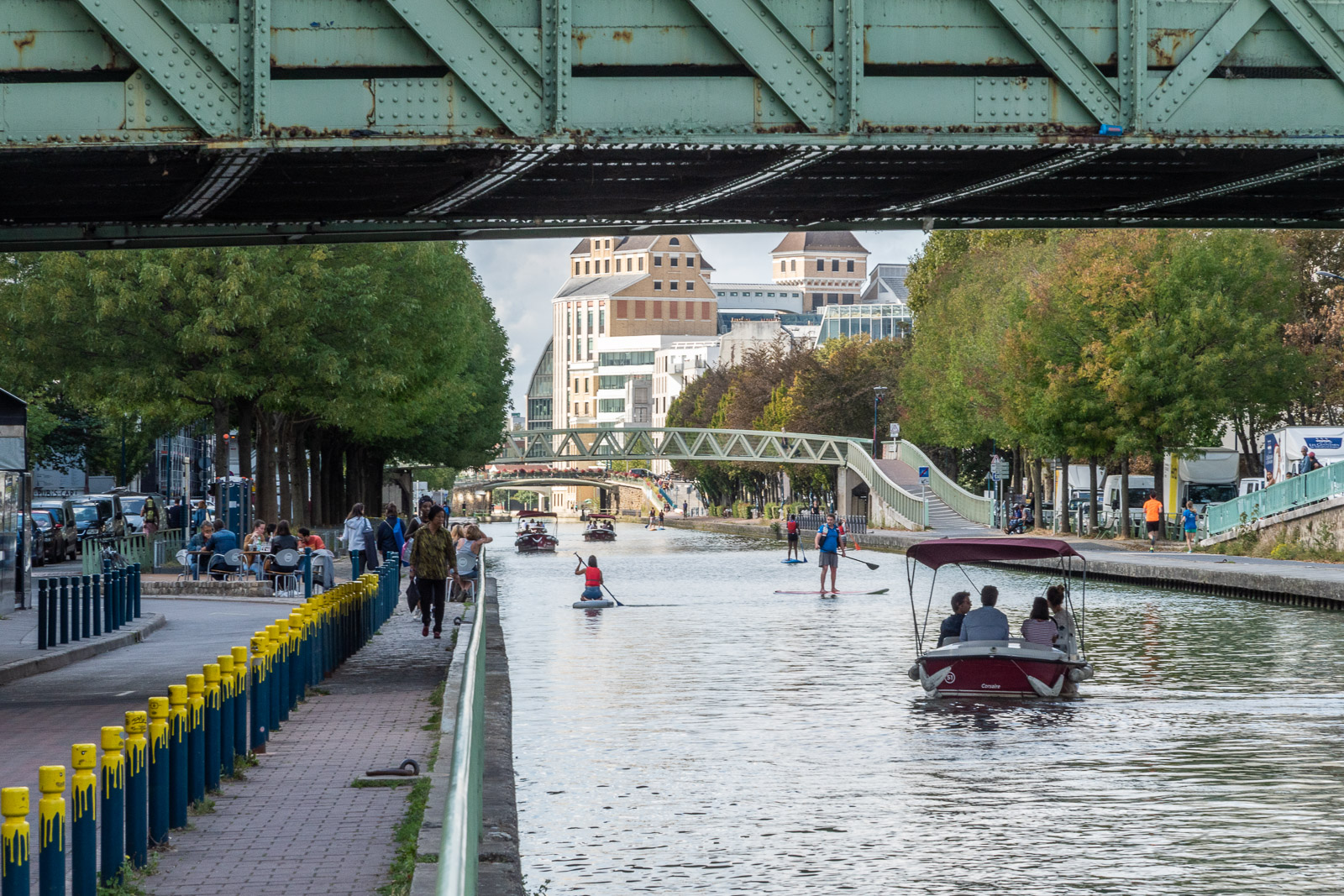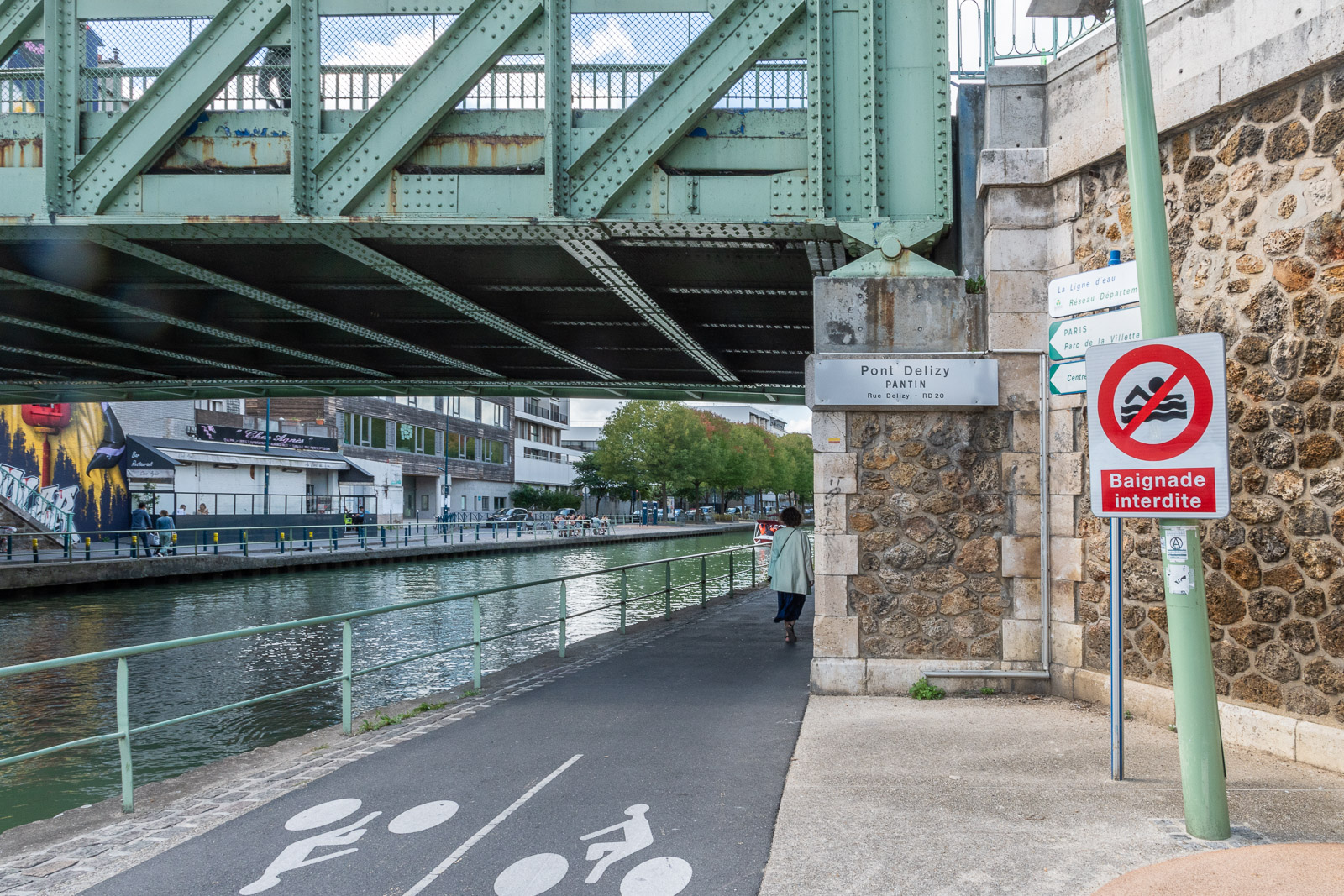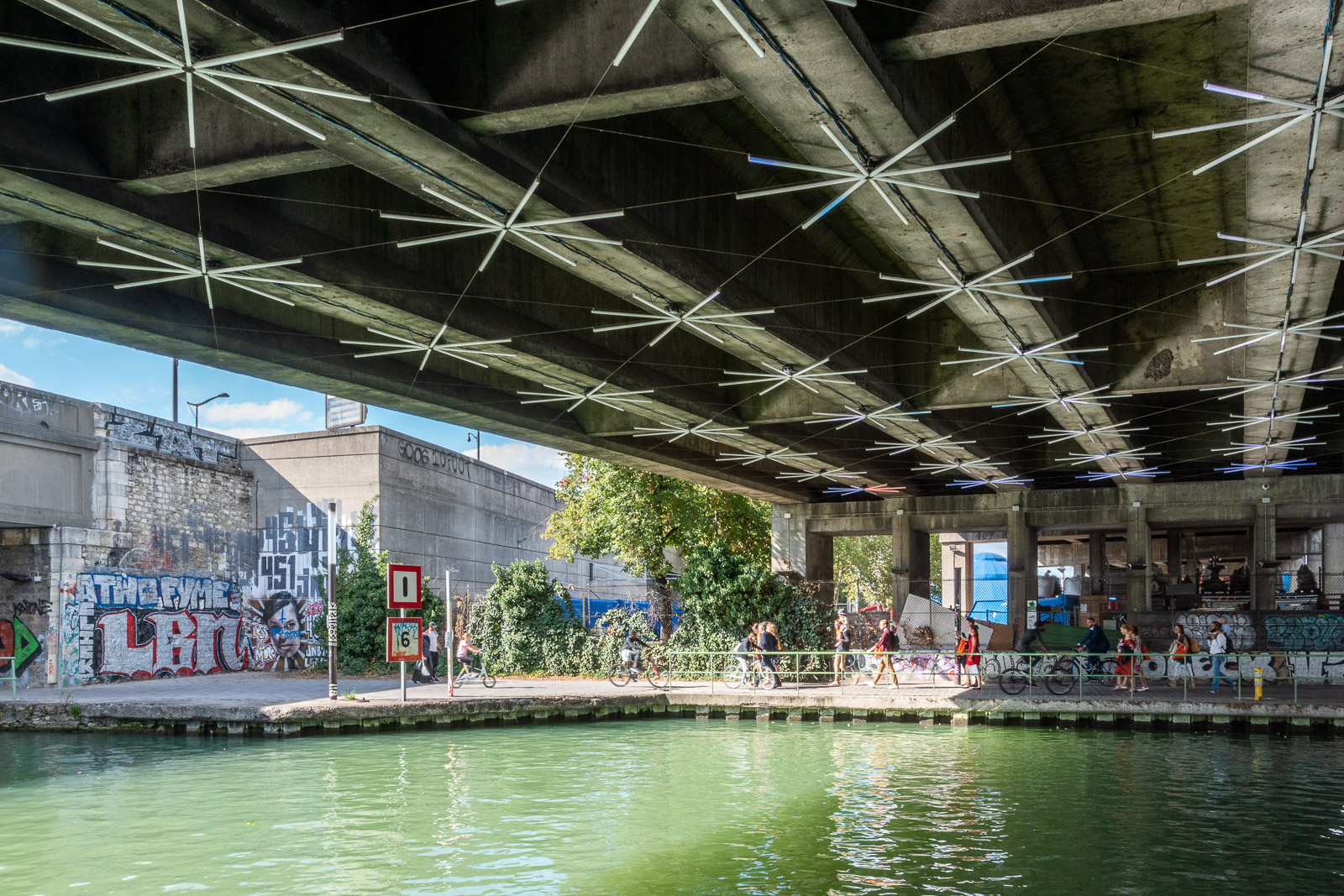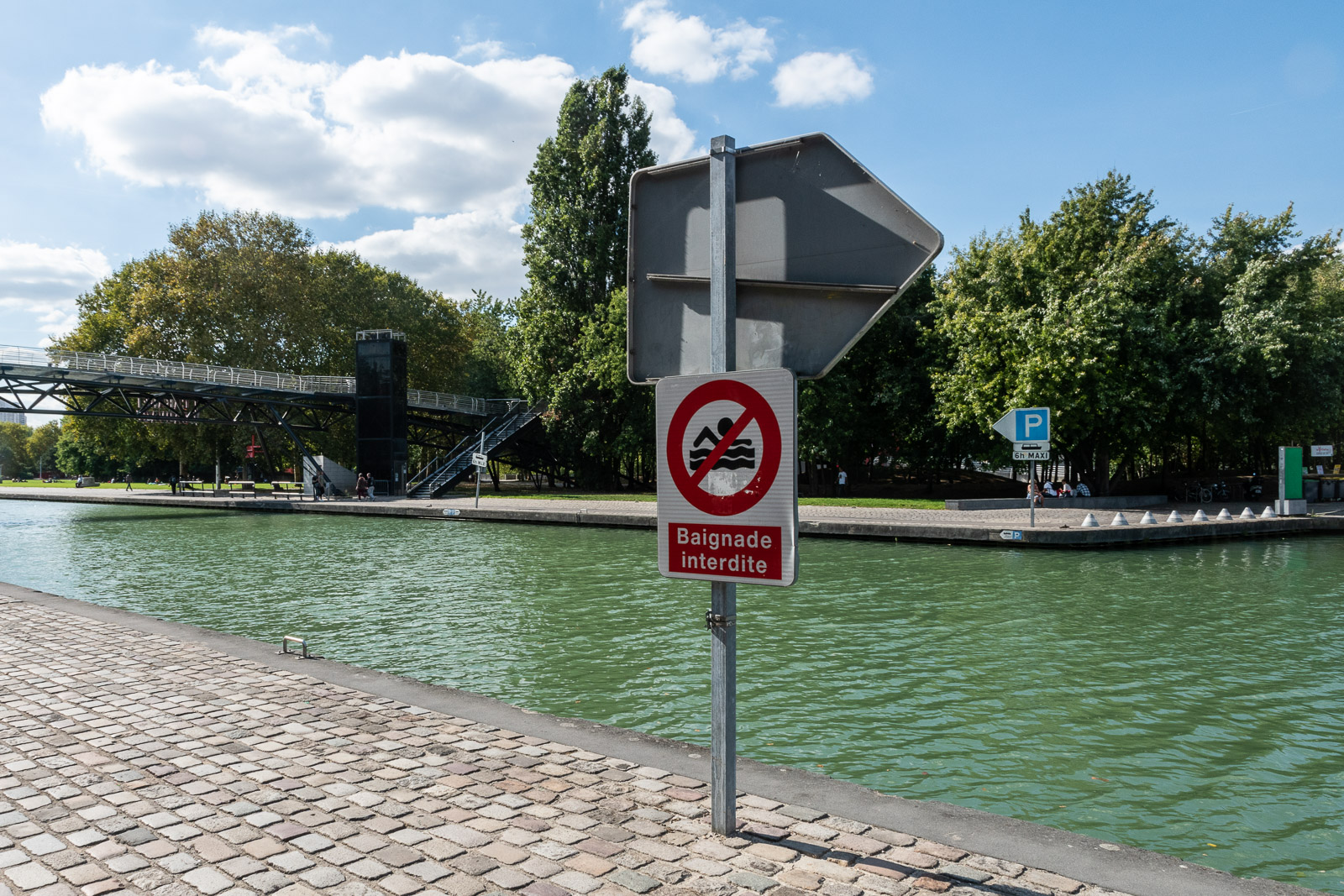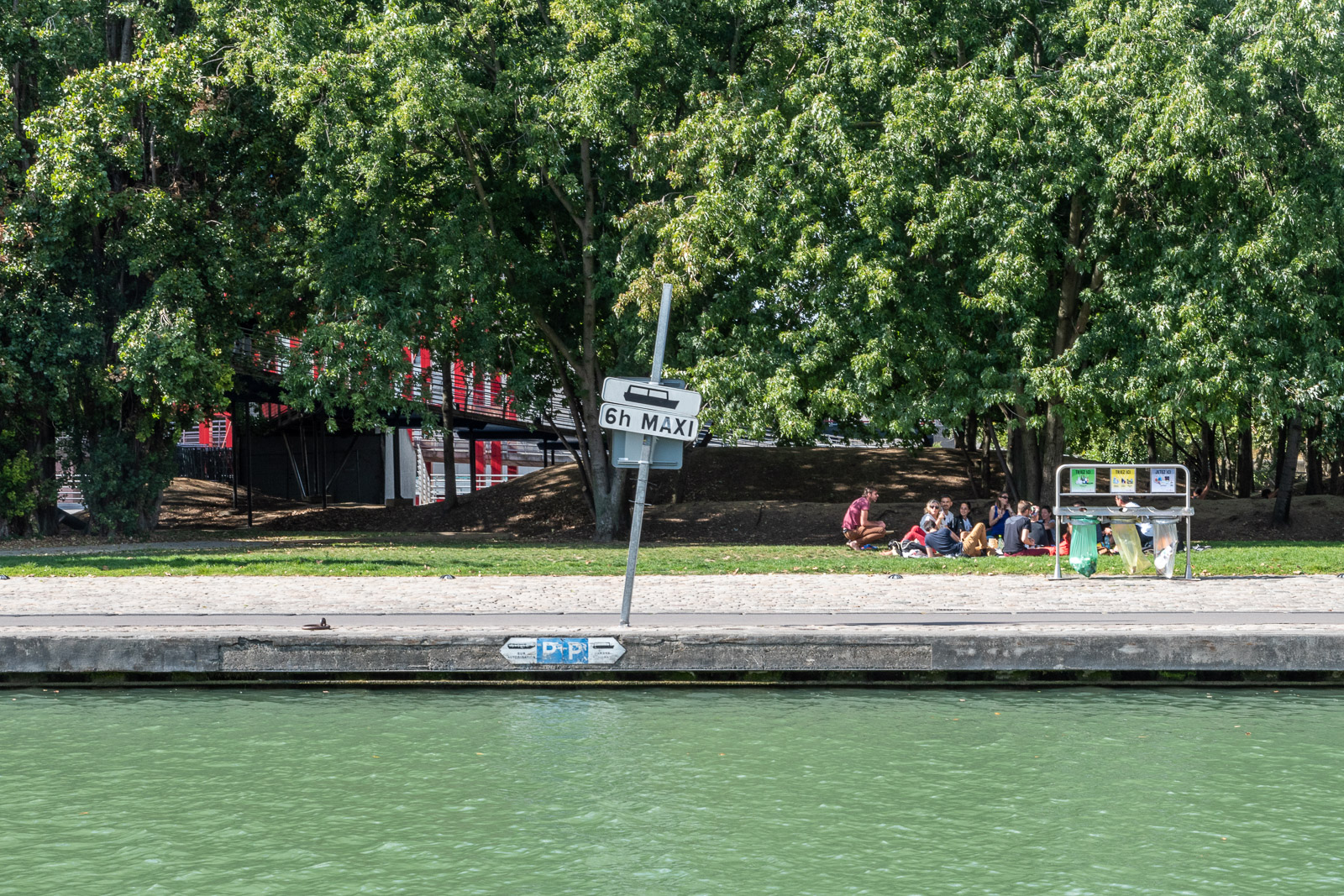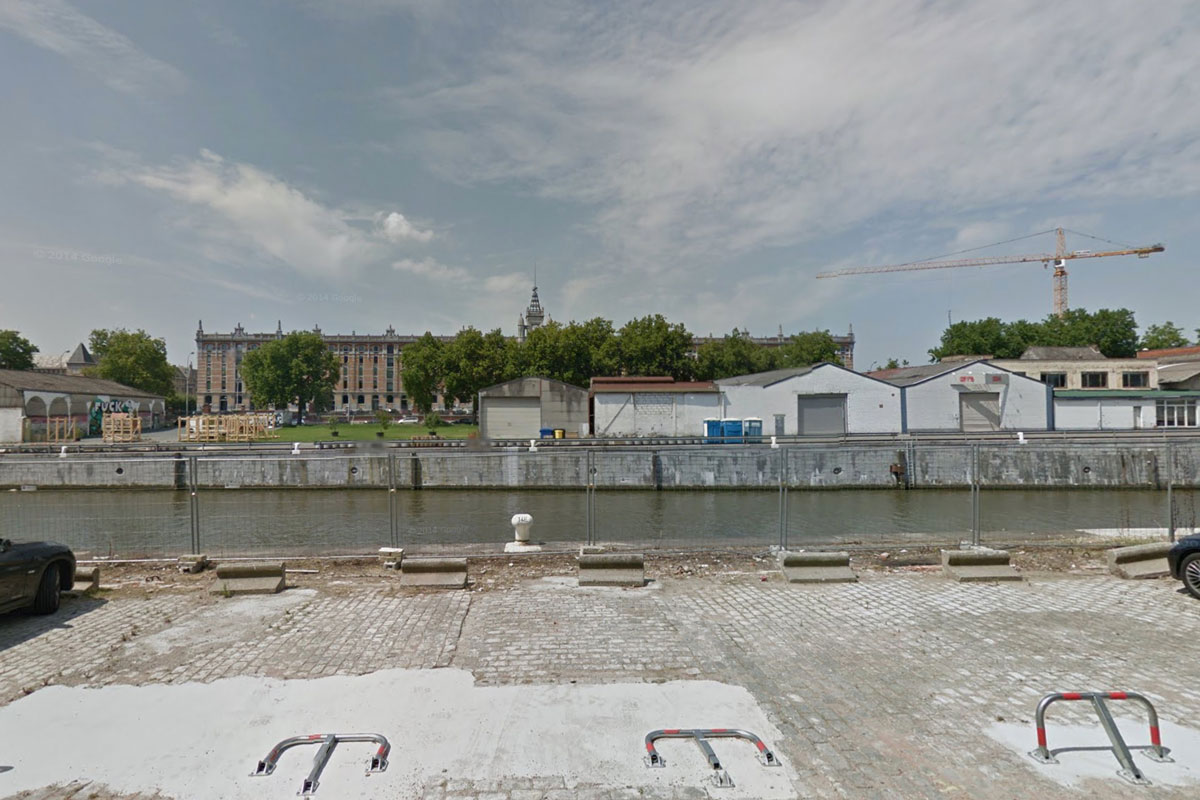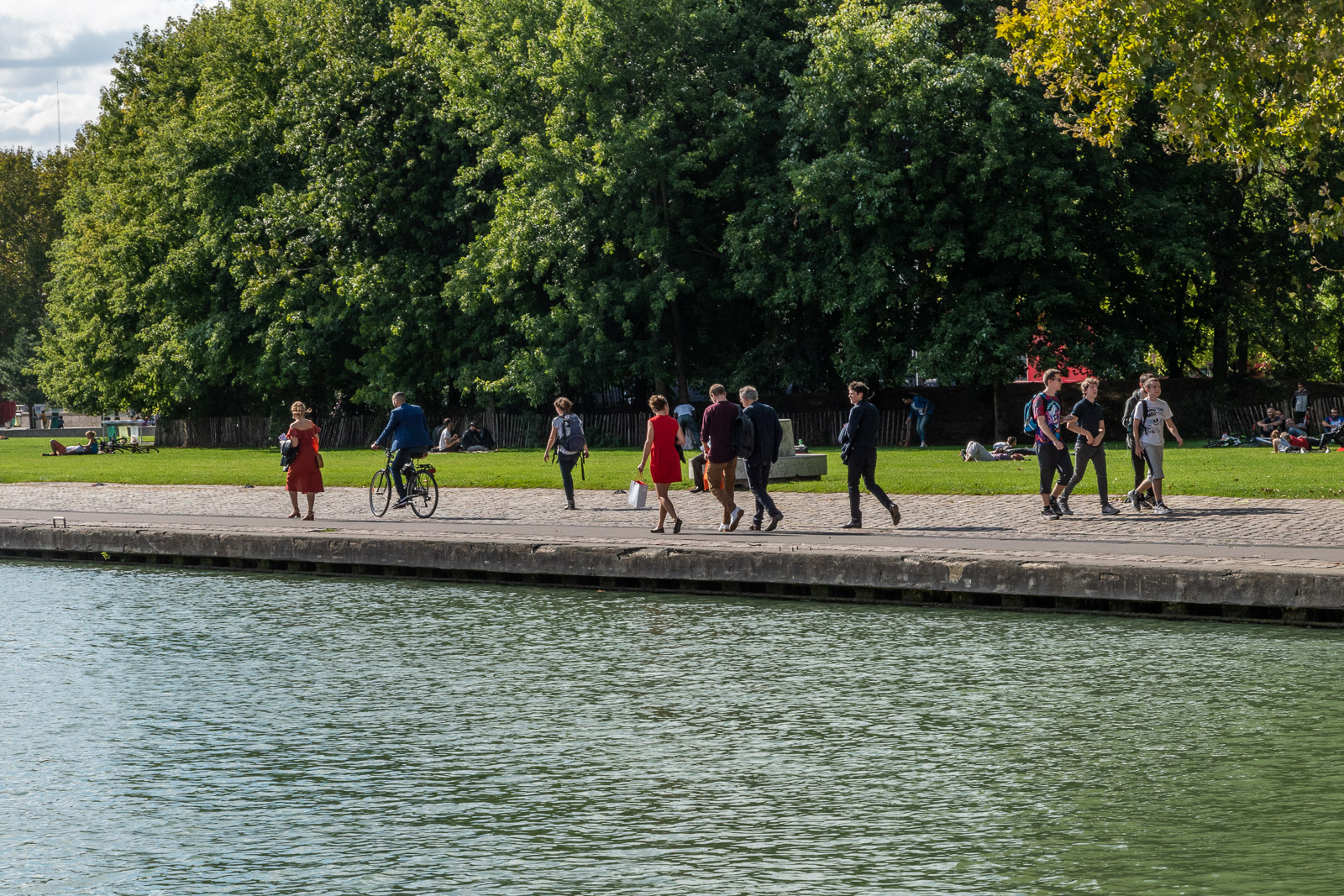Paris 2 - Les canaux comme espace partagé
EN
The canals in the north of Paris are an impressive example of the role that water can play in a city. Could they be taken as examples for the canal in Brussels?
FR
Les canaux au nord de Paris sont un exemple impressionnant du rôle que l’eau peut jouer dans une ville. Pourraient-ils être pris comme exemples pour le canal de Bruxelles?
NL
De kanalen in het noorden van Parijs zijn een indrukwekkend voorbeeld van de rol die water in een stad kan spelen. Zouden ze kunnen worden beschouwd als voorbeelden voor het kanaal in Brussel?
The canals in Paris are the places to do sports, to meet people, to go for a pleasure ride on one of the small boats to rent, to have lunch or dinner, but also to commute by bicycle apart from the heavy traffic on the streets. However, the canal still serves it’s logistic purpose. A good example is the Lafarge concrete factory in Pantin. Instead of blocking the public path along the water to unload the ships that deliver sand and gravel, a loading dock was built that floats in the water from which the material is transported to the factory with a conveyor belt above the path. Both functions, leisure and industry, cross each other without a conflict.
Les canaux de Paris sont l’endroit où faire du sport, rencontrer des gens, faire un tour de plaisance sur l’un des petits bateaux à louer, déjeuner ou dîner, mais aussi se rendre à vélo en dehors de la circulation dense dans les rues. Cependant, le canal sert toujours son objectif logistique. L'usine de béton Lafarge à Pantin en est un bon exemple. Au lieu de bloquer le chemin public le long de l'eau pour décharger les navires qui livrent du sable et du gravier, un quai de chargement a été construit, flottant dans l'eau d'où le matériel est transporté jusqu'à l'usine avec un tapis roulant au-dessus du chemin. Les deux fonctions, loisirs et industrie, se croisent sans conflit.
De kanalen in Parijs zijn de plaats om te sporten, om mensen te ontmoeten, om een pleziertocht te maken op een van de kleine boten om te huren, om te lunchen of te dineren, maar ook om te fietsen, weg van het drukke verkeer op straat . Het kanaal dient echter nog steeds zijn logistieke doel. Een goed voorbeeld is de betonfabriek Lafarge in Pantin. In plaats van het openbare pad langs het water te blokkeren om de schepen die zand en grind leveren te lossen, is een laadperron gebouwd dat in het water drijft vanwaar het materiaal met een transportband boven het pad naar de fabriek wordt getransporteerd. Beide functies, vrije tijd en industrie, kruisen elkaar zonder conflict.
A major contrast with the canal in Brussels is the height difference between water and land. In Brussels it’s several meters, in Paris not even one meter. At many places it’s so low that you can climb out of the canal just like in a swimming pool after swimming (which is officially still forbidden). This close distance creates a completely different perception, the water becomes accessible and suddenly a playground for all kinds of leisure activities.
As a consequence, the low water edge means that bridges are not directly accessible from the path along the water, instead one has to take stairs or ramps to reach a height that permits boats to pass under the bridges. In the centre of Brussels the general layout is inverted. The bridges are mainly on the level of the streets along the canal, the canal is dug deeper so that boats can pass, resulting in the big height difference. That’s a precondition which is difficult to adapt, certainly at narrow parts. However, the redesign of the area along the canal between Sainctelette and Tour&Taxis, from industry to park landscape, could have been the chance to rethink the relation between land and water on a large scale even in the city centre.
Une grande distinction avec le canal de Bruxelles se hauteur entre l’eau et le sol. A Bruxelles, il y a plusieurs mètres, à Paris même pas un mètre. Aux nombreux endroits, il est si bas que vous pouvez sortir du canal comme dans une piscine après avoir nagé (ce qui est toujours interdit). Cette distance réduite crée une perception complètement différente, l'eau devient accessible et devient tout à coup une aire de jeux pour toutes sortes d'activités de loisirs.
Par conséquent, le faible niveau du quai signifie que les ponts ne sont pas directement accessibles depuis le sentier longeant l’eau. Il faut plutôt prendre des escaliers ou des rampes pour atteindre une hauteur permettant aux bateaux de passer sous les ponts. Au centre de Bruxelles, la disposition générale est inversée. Les ponts sont principalement au niveau des rues le long du canal, le canal est creusé plus profondément pour que les bateaux puissent passer, ce qui entraîne une grande différence de hauteur. C’est une condition préalable difficile à adapter, certainement dans des parties étroites. Cependant, la reconception de la zone située entre Sainctelette et Tour & Taxis, de l’industrie au parc, aurait pu être l’occasion de repenser la relation entre la terre et l’eau à grande échelle, même dans le centre-ville.
Een groot contrast met het kanaal in Brussel is het hoogteverschil tussen water en land. In Brussel is het enkele meters, in Parijs nog geen meter. Op veel plaatsen is het zo laag dat je uit het kanaal kunt klimmen, net als in een zwembad na het zwemmen (wat officieel nog steeds verboden is). Deze verkleinde afstand creëert een heel andere perceptie, het water wordt toegankelijk en zo opeens een speeltuin voor allerlei soorten vrijetijdsactiviteiten.
Echter betekent de lage kaaimuur ook dat bruggen niet direct toegankelijk zijn vanaf het pad langs het water, in plaats daarvan moet men trappen of hellingen nemen om een hoogte te bereiken die boten onder de bruggen doorlaat. In het centrum van Brussel is de algemene layout omgekeerd. De bruggen bevinden zich voornamelijk op het niveau van de straten langs het kanaal, het kanaal is dieper ingegraven zodat boten kunnen passeren, wat resulteert in het grote hoogteverschil. Dat is een randvoorwaarde die moeilijk aan te passen is, zeker op nauwere stukken. Het herontwerp van het gebied langs het kanaal tussen Sainctelette en Tour & Taxis, van industrie tot park, had echter de kans kunnen bieden om de relatie tussen land en water op grote schaal te heroverwegen, zelfs in het stadscentrum.
The reason that blocks such radical changes of the canal in Brussels could be the fact that it’s today managed only by the harbor of Brussels, a publicly owned company. They consider it merely as an infrastructure for transport, like a highway for boats. It’s undeniable that the transport by boat, which spares the streets of thousands of trucks and their exhaust fumes, has an important positive impact on the traffic and air quality. However, focussing only on the commercial aspect of the canal denies not only its possible importance for an augmented living quality for the citizens of Brussels compared to the example in Paris, but also the fact that it’s by far Brussels’ largest habitat for water life like fishes, birds and plants.
Today’s plans for the renovation of the canal zone stop always precisely on the water edge (or even earlier). We think it’s time to discuss this entrenched state to make the water accessible in order to develop the full spatial, social and ecological potential of the canal on top of its economic importance.
La raison qui bloque ces changements radicaux du canal à Bruxelles pourrait être le fait qu’elle est actuellement gérée uniquement par le port de Bruxelles, une entreprise publique. Ils le considèrent simplement comme une infrastructure de transport, comme une autoroute pour les bateaux. Il est indéniable que le transport par bateau, qui épargne les rues de milliers de camions et leurs gaz d’échappement, a un impact positif important sur la circulation et la qualité de l’air. Cependant, se concentrer uniquement sur l'aspect commercial du canal nie non seulement son importance pour une qualité de vie augmentée pour les citoyens bruxellois par rapport à l'exemple parisien, mais aussi le fait qu'il constitue de loin le plus grand habitat bruxellois pour la vie aquatique comme poissons, oiseaux et plantes.
Les projets actuels de rénovation de la zone du canal s’arrêtent toujours précisément au bord de l’eau (ou même plus tôt). Nous pensons qu’il est temps de discuter cet état enraciné afin de développer le plein potentiel spatial, social et écologique du canal en plus de son importance économique.
De reden dat dergelijke radicale veranderingen van het kanaal in Brussel niet gebeuren, zou kunnen zijn dat het vandaag alleen wordt beheerd door de haven van Brussel, een overheidsbedrijf. Zij beschouwen het louter als een infrastructuur voor transport, zoals een snelweg voor boten. Het valt niet te ontkennen dat het transport per boot, dat de straten van duizenden vrachtwagens en hun uitlaatgassen spaart, een belangrijke positieve invloed heeft op de verkeers- en luchtkwaliteit. Echter, zich alleen concentreren op het commerciële aspect van het kanaal ontkent niet alleen het mogelijke belang voor een verhoogde levenskwaliteit voor de Brusselaars zoals aangetoond met het voorbeeld in Parijs, maar ook het feit dat het verreweg het grootste Brusselse waterhabitat is voor vissen, vogels en planten.
De plannen van vandaag voor de renovatie van de kanaalzone stoppen altijd precies op de waterrand (of zelfs eerder). We denken dat het tijd is om deze diepgewortelde gewoonte in vraag te stellen en het water toegankelijk te maken om zo het volledige ruimtelijke, sociale en ecologische potentieel van het kanaal te ontwikkelen, bovenop het economische belang ervan.

